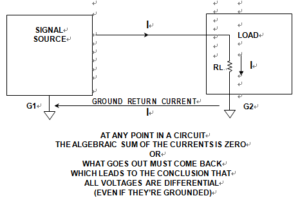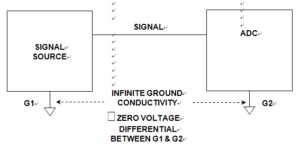Signal Return Currents
Kirchoff’s Law tells us that at any point in a circuit the algebraic sum of the currents is zero. This tells us that all currents flow in circles and, particularly, that the signal return current must always be considered when analyzing a circuit, as is illustrated in below Figure.
In dealing with grounding issues, common human tendencies provide some insight into how the correct thinking about the circuit can be helpful towards analysis. Most engineers readily consider the ground return current “I,” only when they are considering a fully differential circuit.
However, when considering the more usual circuit case, where a single-ended signal is referred to “ground,” it is common to assume that all the points on the circuit diagram where ground symbols are found are at the same potential. Unfortunately, this happy circumstance just ain’t necessarily so!
This overly optimistic approach is illustrated in below Figure where, if it really should exist, “infinite ground conductivity” would lead to zero ground voltage difference between source ground G1 and load ground G2. Unfortunately this approach isn’t a wise practice, and when dealing with high precision circuits, it can lead to disasters.



